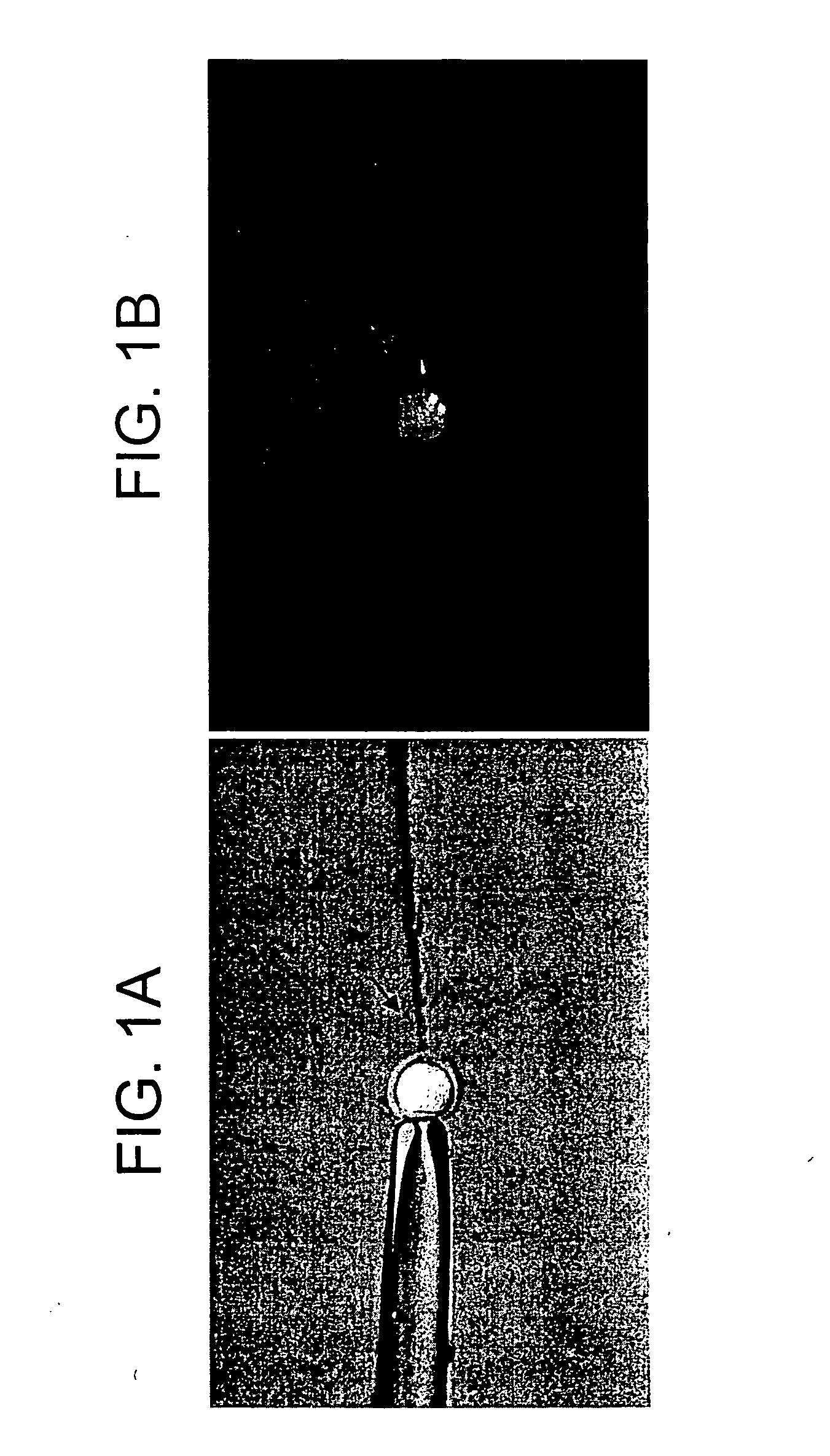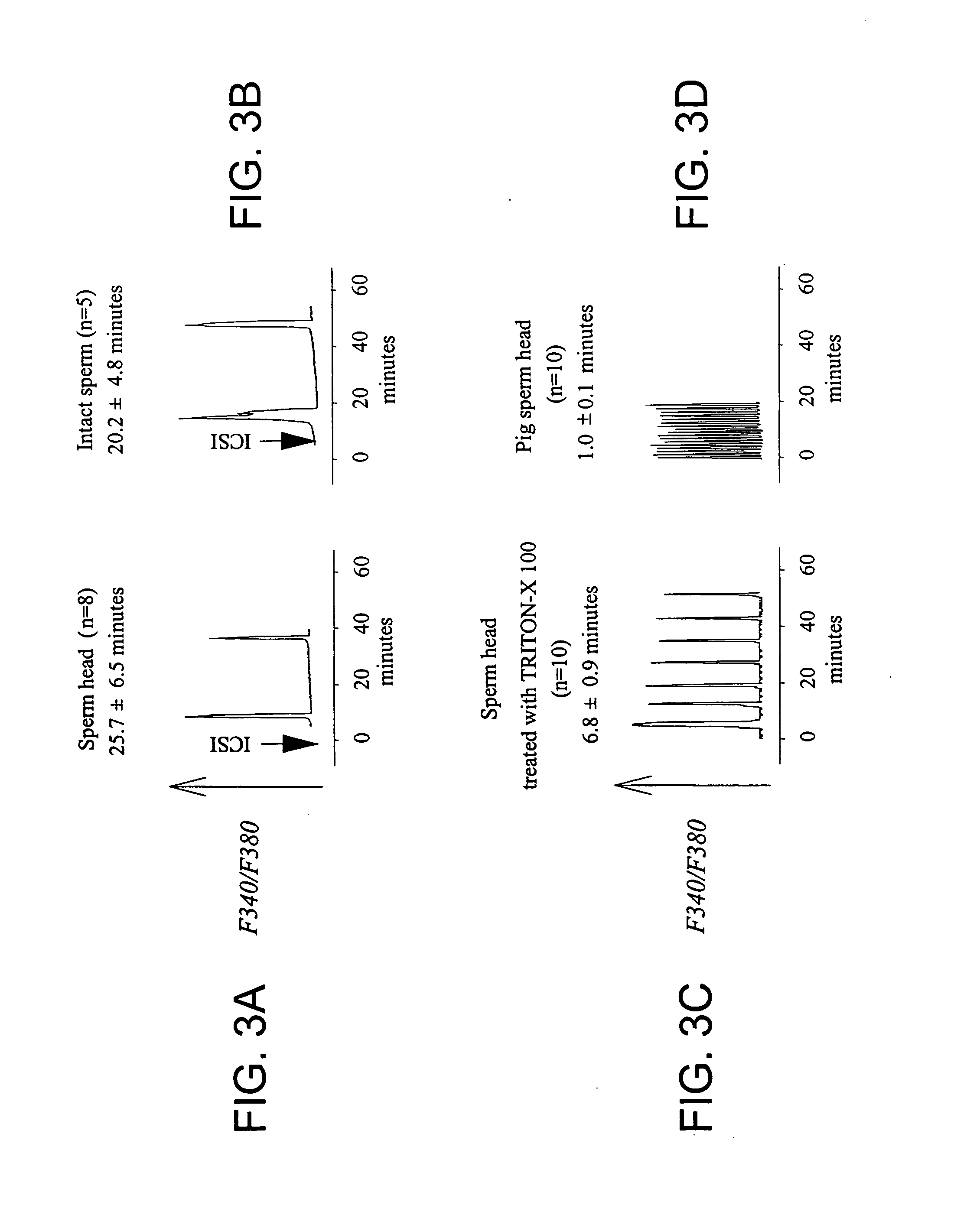Sperm-induced cellular activation
a cellular activation and sperm technology, applied in the field of artificial reproduction technology, can solve the problems of inability to easily extend the method of parthenogenetic activation to oocyte activation in large domestic species, the possibility of harm to the resultant cloned animal, and the inability to test the deleterious effects of these treatments on the active casup>2+/sup> molecule(s), so as to improve the efficiency of in vitro fertilization
- Summary
- Abstract
- Description
- Claims
- Application Information
AI Technical Summary
Benefits of technology
Problems solved by technology
Method used
Image
Examples
example 1
Embryological Methods
[0102] Female B6D2F1 mice between 6 and 12 weeks of age were superovulated by sequential injections of 5 IU of ECG (equine gonadotropin from pregnant mare serum; available from Sigma-Aldrich of St. Louis, Mo.) followed by injection of 5 IU of hCG (human chorionic gonadotropin; available from Sigma-Aldrich of St. Louis, Mo.), as previously described (Wu et al., 1998). Metaphase II eggs were collected from the oviducts of stimulated females 14 hours following hCG injection.
[0103] Metaphase II eggs were collected in TL-Hepes (Parris et al., 1988; Wu et al., 1998) supplemented with 10% heat-treated fetal calf serum. ICSI was also performed in this medium. Cumulus cells were removed by a brief exposure to hyaluronidase (0.025%). Eggs were cultured in 50 μL drops of KSOM (Specialty Media of Phillisburg, N.J.) under paraffin oil at 36.5° C. in a humidified atmosphere containing 7% CO2. The zona pellucida was removed by incubating the eggs in acid Tyrode's solution (H...
example 2
Monitoring Calcium Oscillations
[0109] Oocyte activation was monitored by assaying calcium oscillations following a presumptive or candidate activating event, for example by using a calcium indicator such as fura-2 dextran (10 kDa Fura-2D; available from Molecular Probes, Inc. of Eugene, Oreg.) as previously described (Wu and Zhang, 1998). UV illumination was provided by a 75 watt xeon arc lamp, using 340 and 380 nm excitation wavelengths. The intensity of the UV light was attenuated 32-fold with neutral density filters, and a photomultiplier tube was used to quantify the emitted light after passing through a 500 nm barrier filter. The fluorescence signal was averaged for the whole egg. A modified PHOSCAN® 3.0 software program (Nikon, Inc. of New York, N.Y.), which was run on a 486 IBM-compatible system, controlled the rotation of the filter wheel and shutter apparatus to alternate wavelengths. Free [Ca2+], was determined from the 340 nm / 380 nm ratio of fluorescence. Rmin and Rmax w...
example 3
ICSI-Induced [Ca2+]i Oscillations Are Similar to Those Observed After IVF and Are Prolonged by Colcemid Treatment
[0112] As shown in FIG. 2, fertilization by ICSI faithfully replicates the pattern of calcium oscillations initiated by IVF in mouse eggs, similar to that described by Sato et al. (1999) Cell Calcium 26:49-58 and by Nakano et al. (1997) Mol Hum Reprod 3:1087-93. ICSI performed in the presence of colcemid, a microtubule inhibitor drug that arrests eggs in a metaphase-like stage, significantly prolonged calcium responses. In particular, calcium oscillations persisted for at least about 8-10 hours, as previously reported for IVF-induced oscillations (Jones et al., 1995). These results show that the immediate release, and potentially the persistent release, of the sperm's Ca2+ active factor occurs similarly after ICSI and IVF. Thus, ICSI is a valid model to study the release of the sperm's Ca2+ active factor during mouse fertilization.
PUM
| Property | Measurement | Unit |
|---|---|---|
| excitation wavelengths | aaaaa | aaaaa |
| excitation wavelengths | aaaaa | aaaaa |
| pH | aaaaa | aaaaa |
Abstract
Description
Claims
Application Information
 Login to View More
Login to View More - R&D
- Intellectual Property
- Life Sciences
- Materials
- Tech Scout
- Unparalleled Data Quality
- Higher Quality Content
- 60% Fewer Hallucinations
Browse by: Latest US Patents, China's latest patents, Technical Efficacy Thesaurus, Application Domain, Technology Topic, Popular Technical Reports.
© 2025 PatSnap. All rights reserved.Legal|Privacy policy|Modern Slavery Act Transparency Statement|Sitemap|About US| Contact US: help@patsnap.com



